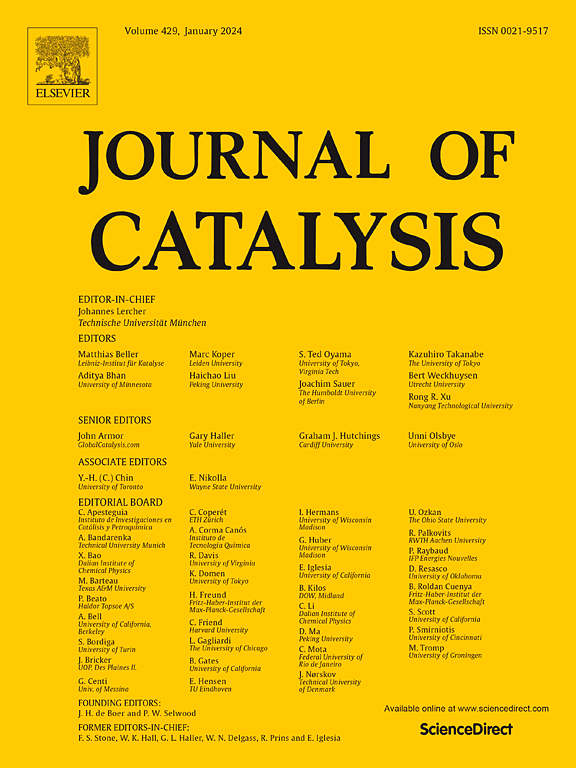Unraveling the role of CH3S* intermediates for efficient methane and hydrogen sulfide reforming over Mo/Al2O3 catalysts
IF 6.5
1区 化学
Q2 CHEMISTRY, PHYSICAL
引用次数: 0
Abstract
The catalytic methane(CH4) and hydrogen sulfide(H2S) reforming (H2SMR) represents a promising approach for producing high-value sulfur-carbon compounds and hydrogen without generating the greenhouse gas of CO2. Despite its significant potential, the mechanistic understanding of interactions between CH4 and H2S remains contentious, posing substantial challenges for catalyst development. In this study, we employed a Mo/Al2O3 catalyst to elucidate synergistic conversion pathways between CH4 and H2S during H2SMR. At 1173 K with a reaction duration of 0.5 h, conversion rates of CH4 and H2S reached 63.7 % and 59.2 %, respectively, accompanied by H2 and CS2 production rates of 688.8 μmol g−1 min−1 and 444.3 μmol g−1 min−1, respectively. Notably, the catalyst exhibited stable performance over 5 h without significant deactivation, in contrast to pure methane cracking reactions where CH4 conversion rapidly declined from 43.6 % to 14.3 %. Through in-situ diffuse reflectance infrared Fourier transform spectroscopy (DRIFTS) combined with alternating CH4/H2S exposure experiments, we successfully tracked the synergistic conversion pathway on the Mo/Al2O3 catalyst. These investigations revealed that the formation of CH3S intermediates serves as a critical step facilitating CS2 generation. This mechanistic insight not only advances fundamental understanding of H2SMR reaction pathways but also provides a rational foundation for designing optimized catalysts with enhanced stability and extended operational lifetimes. The identification of this intermediate-driven mechanism addresses previous controversies regarding CH4-H2S interactions and offers strategic guidance for developing efficient sulfur-resistant catalytic systems.


揭示CH3S*中间体在Mo/Al2O3催化剂上高效甲烷和硫化氢重整中的作用
催化甲烷(CH4)和硫化氢(H2S)重整(H2SMR)是一种很有前途的方法,可以在不产生二氧化碳温室气体的情况下生产高价值的硫碳化合物和氢。尽管具有巨大的潜力,但对CH4和H2S之间相互作用的机理理解仍然存在争议,这给催化剂的开发带来了重大挑战。在这项研究中,我们使用Mo/Al2O3催化剂来阐明H2SMR过程中CH4和H2S之间的协同转化途径。在1173 K 反应持续时间为0.5 h,甲烷的转化率和H2S达到63.7 % %和59.2,分别伴随着H2和CS2生产速度688.8 μ摩尔 g−1 分钟−1和444.3 μ摩尔 g−1 分钟−1,分别。值得注意的是,该催化剂在5 h内表现出稳定的性能,没有明显的失活,而纯甲烷裂解反应的CH4转化率从43.6% %迅速下降到14.3% %。通过原位漫反射红外傅里叶变换光谱(DRIFTS)结合CH4/H2S交替暴露实验,我们成功地追踪了Mo/Al2O3催化剂上的协同转化途径。这些研究表明,CH3S中间体的形成是促进CS2生成的关键步骤。对H2SMR反应机理的深入了解不仅促进了对H2SMR反应途径的基本认识,而且为设计具有更高稳定性和更长的使用寿命的优化催化剂提供了合理的基础。这种中间体驱动机制的发现解决了之前关于CH4-H2S相互作用的争议,并为开发高效的耐硫催化体系提供了战略指导。
本文章由计算机程序翻译,如有差异,请以英文原文为准。
求助全文
约1分钟内获得全文
求助全文
来源期刊

Journal of Catalysis
工程技术-工程:化工
CiteScore
12.30
自引率
5.50%
发文量
447
审稿时长
31 days
期刊介绍:
The Journal of Catalysis publishes scholarly articles on both heterogeneous and homogeneous catalysis, covering a wide range of chemical transformations. These include various types of catalysis, such as those mediated by photons, plasmons, and electrons. The focus of the studies is to understand the relationship between catalytic function and the underlying chemical properties of surfaces and metal complexes.
The articles in the journal offer innovative concepts and explore the synthesis and kinetics of inorganic solids and homogeneous complexes. Furthermore, they discuss spectroscopic techniques for characterizing catalysts, investigate the interaction of probes and reacting species with catalysts, and employ theoretical methods.
The research presented in the journal should have direct relevance to the field of catalytic processes, addressing either fundamental aspects or applications of catalysis.
 求助内容:
求助内容: 应助结果提醒方式:
应助结果提醒方式:


